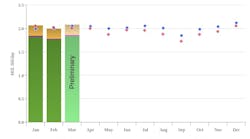The US drilling rig count jumped 20 units to 588 during the week ended Nov. 18, according to Baker Hughes Inc. data. It’s the count’s largest increase since April 2014, several months before the beginning of a steep drilling dive that lasted a year and a half.
Despite oil prices mostly remaining below the $50/bbl threshold, the tally of active rigs has risen by double digits in 5 of the last 8 weeks, adding 184 units since the recent drilling rebound began after May 27 (OGJ Online, Nov. 14, 2016). It’s now down 1,332 units since Dec. 5, 2014.
Staying true to form, rigs targeting oil, drilling horizontally, and operating in the Permian basin provided much of the upward lift this week.
Oil-directed rigs represented all but one of those units to come online, boosting their count to 471, an increase of 155 since May 27. Natural gas-directed rigs edged up 1 unit to 116, up 35 units since Aug. 26. One rig considered unclassified remains operational.
Land-based rigs gained 17 units to 563, down just 162 year-over-year. Horizontal rigs rose 13 units to 470, up 156 since May 27.
A tale of two regions
The Permian basin of West Texas and southeastern New Mexico jumped 11 units this week to 229, up 95 since May 13. The increased drilling in the basin since last spring has resulted in higher estimated quantities of drilled but uncompleted (DUC) wells and higher projected crude oil production in the region.
According to the US Energy Information Administration’s latest Drilling Productivity Report (DPR), the Permian’s DUC tally spiked by 85 wells in October to 1,467, lifting the DUC count of the seven major US oil and gas producing regions by 58 to 5,155 (OGJ Online, Nov. 14, 2016).
Crude production in the Permian during December is forecast to rise 27,000 b/d to 2.065 million b/d. However, combined crude output from the seven regions covered by the DPR is expected to fall 20,000 b/d to 4.498 million b/d.
A formidable counterforce on the Permian’s gains in recent months, the neighboring Eagle Ford is expected to see its oil output in December fall below 1 million b/d for the first time since April 2013 with a 33,000-b/d decline to 978,000 b/d. The South Texas shale play dropped 30 DUC wells in October to 1,309, and its rig count this week was flat at 38, still up 7 units since Oct. 14.
Adding to the increasing appeal of the Permian is the US Geological Survey’s assessment of the Midland basin portion of the Wolfcamp shale, which the agency said this week may hold 20 billion bbl of oil (OGJ Online, Nov. 16, 2016).
The Wolfcamp estimate is nearly three times that of the 2013 USGS Bakken-Three Forks resource assessment, making it the largest estimated continuous oil accumulation that USGS has assessed to date in the US.
A hundred more Texas rigs
Largely lifted by the Permian, Texas gained 8 units this week to 276, representing an increase of 103 since May 27. The Granite Wash rose a unit to 11, offsetting a 1-unit decrease in the Barnett to 2.
Oklahoma and Louisiana each collected 4 active rigs to respective totals of 79 and 52. Oklahoma has added 25 units since June 24. The Haynesville gained 2 units to 23, up 10 since Sept. 30.
Two rigs started work offshore Louisiana, bringing the overall US offshore count to 23. One rig drilling in inland waters also came online, doubling that tally.
Ohio and the Utica each climbed 3 units to 18 and 19, respectively. Colorado and the DJ-Niobrara each gained 2 units to respective tallies of 20 and 18. Utah increased a unit to 5.
North Dakota, Pennsylvania, and Wyoming each lost 1 unit to respective counts of 34, 25, and 16. The Williston and Marcellus, each down 1 unit, now total 34 each.
Canadian drilling increases
The rig count in Canada rose for a fourth consecutive week with an 8-unit climb to 184, up 148 since May 6 and the country’s largest tally since Feb. 19.
As with the US rebound, Canada’s recent drilling increases have been bolstered by the proliferation of active oil-directed rigs, which jumped 11 units this week to 100, a far cry from the 8 rigs working on Apr. 8. Gas-directed rigs, meanwhile, dropped 3 units to 84, but are still up 60 since May 6.
In its recently released 2017 Canadian Drilling Activity Forecast, the Petroleum Services Association of Canada (PSAC) said it expects 4,175 wells to be drilled in Canada next year, compared with a final revised forecast of 3,950 wells this year.
Although PSAC expects 2017 activity to improve slightly year-over-year, the projected total is still 63% lower than the number of wells drilled in 2014.
“We are seeing a small uptick in activity for 2016-17 as we head in to our traditional winter drilling and completion season,” said Mark Salkeld, PSAC president. “Beyond that, it is hard to find support for any significant ramp up of activity over what we are forecasting, as geopolitics and increased supply continue to keep commodity prices low, and lack of access to global markets keeps a chokehold on the Canadian industry.”
PSAC estimates 1,940 wells will be drilled in Saskatchewan next year, up 240 year-over-year; and 1,900 in Alberta, up 53 year-over-year. Meanwhile, 2017 drilling activity is expected to fall in Manitoba to 50 wells, down 24 year-over-year; and in British Columbia to 280 wells, down 40 year-over-year.
Contact Matt Zborowski at [email protected].
